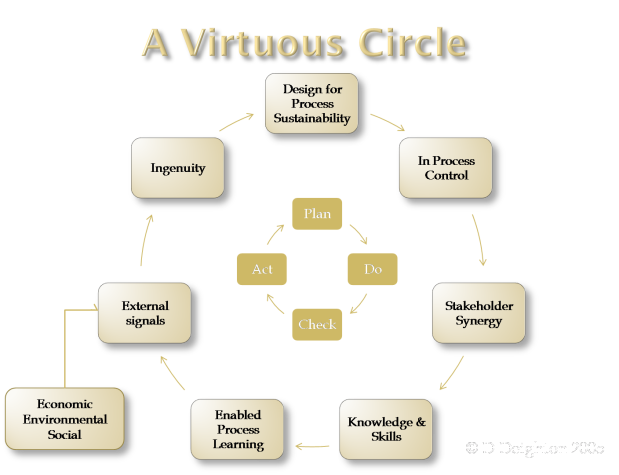The clip below is part of my June 2005 comment on the UK Northwest ‘Economic Baseline Assessment’ and as I commented towards the end
“My firm feeling after six years is that the Western economies (not just us) are going down the reductionist/compliance route; which is making synergy impossible and innovation and ingenuity unlikely. There is also the real risk that knowledge and skills development will be concentrated in the wrong areas and vital areas missed.”
QED the Credit Crunch
https://trailblazerbusinessfutures.wordpress.com/2009/01/29/the-maths-of-the-credit-crunch/
dd
In the Baseline Report only the economic strand of the ‘triple bottom line’ of Sustainable Development is being discussed, this may be possible in a report but it perpetuates the myth that they can be considered separately, although to be fair, challenge 6 in the Report does say they are interlinked. ‘Securing the future’ specifically recommends the use of the SIGMA Guidelines www.projectsigma.co.uk which binds all the SD strands together.
The challenges listed are
· business (professional) services
· skills gap
· enterprise gap
· innovation gap
· knowledge gap
Professional services are increasingly at the core of the problem surrounding Sustainable Development, as is the tendency of large organisations to use complexity to ‘divide and rule’. The need for a ‘unique selling point (USP)’ leads academics and professionals to sell every ‘tool’ as a solution.
Next the tendency is to enshrine these ‘tools’ in ‘standards’, which in turn become certifiable to create a ‘standards industry’, and work for them. This burdens businesses with ‘appraisal costs’, which make them uncompetitive in world markets.
Far more insidious is the fact that it engenders a compliance culture, where companies live in fear of losing ‘ticks in boxes’ and the other four challenges are thus created.
What is needed is a synergy between all the stakeholders in a organisation to liberate the ingenuity that will drive the ‘virtuous circle’.
If we are to make ‘SD the route for competitiveness’, as was stated in the original Regional Development Stratery, then we have to work to continually improve ‘process design for sustainability’.
We can only do this with a synergy of all the stakeholders involved to pool knowledge and skills; to crosslink and identify and correct deficiencies. Doing this should ‘enable process learning’ to locate the problem areas.
Now we have to take account of external factors before, hopefully, the ‘spark of ingenuity or innovation’ is ignited to move the process in the direction of sustainability. This is conventionally termed ‘quality improvement’
My firm feeling after six years is that the Western economies (not just us) are going down the reductionist/compliance route; which is making synergy impossible and innovation and ingenuity unlikely. There is also the real risk that knowledge and skills development will be concentrated in the wrong areas and vital areas missed.
The most vital area at the moment is research and skills creation in the ‘demand side management of energy’ to mitgate the, now almost unavoidable, crisis coming.
https://trailblazerbusinessfutures.wordpress.com/2009/01/29/the-virtuous-circle/
Securing the Future http://www.defra.gov.uk/sustainable/government/publications/uk-strategy/index.htm

2 comments